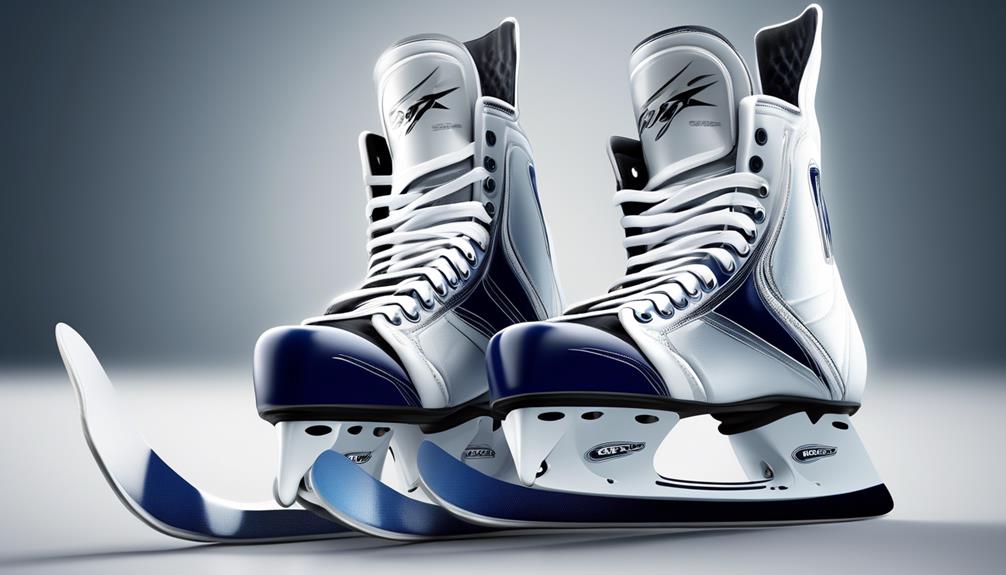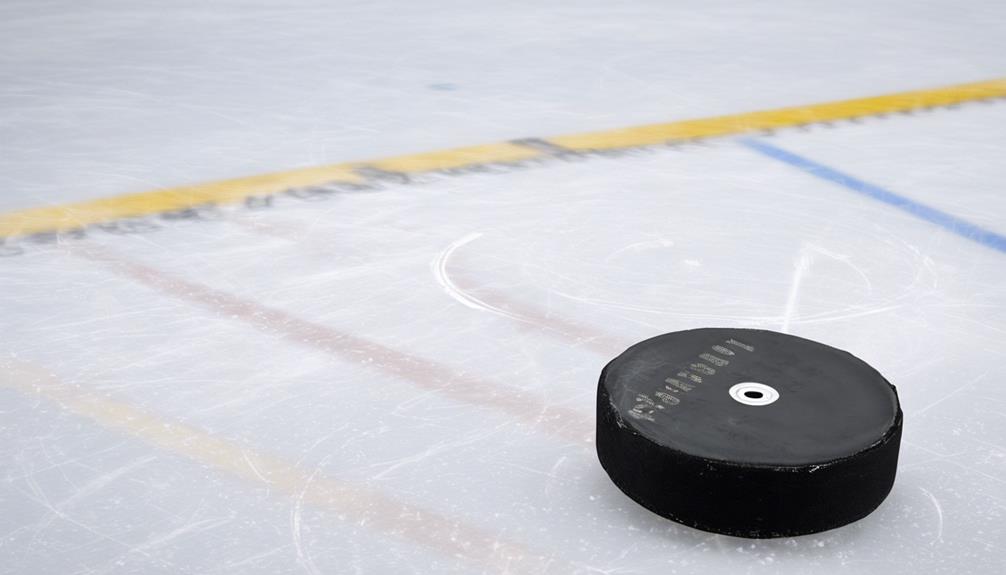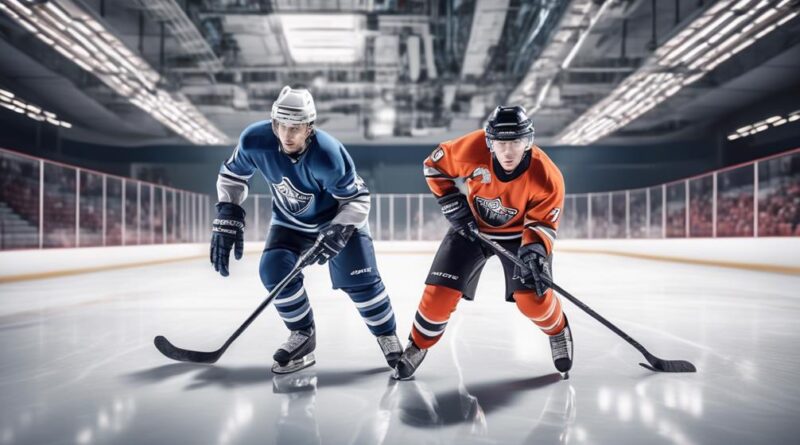Optimizing Hockey Gear for Small Rinks: 4 Tips
You may have heard that good things often come in small packages, and when it comes to hockey gear for small rinks, the same can be said.
Whether you're a seasoned player or just starting out, optimizing your gear for a smaller rink can make a significant difference in your performance.
From choosing the right skates to customizing your gear for agility, there are several key considerations to keep in mind.
So, if you want to ensure that you're making the most of your gear in a smaller rink, there are four essential tips that can help you step up your game.
Choosing the Right Skates

When selecting the right skates for small rinks, prioritize agility and maneuverability over speed and power. The smaller rink size demands quick turns and rapid changes in direction, making agility a crucial factor in your skate choice. Look for skates that offer a custom fit for optimal comfort and performance.
A custom skate fit ensures that your skates provide the necessary support without causing discomfort or pain, allowing you to focus on your game. Additionally, consider the blade sharpening techniques. Opt for a shallower hollow when sharpening your blades for small rinks, as this allows for quicker and more controlled movements.
A shallower hollow provides better bite and maneuverability, enabling you to make sharp turns with ease. When it comes to agility and maneuverability, the blade profile also plays a significant role. Choose a blade profile that enhances your ability to maneuver quickly on the ice.
Seek out skates with a shorter blade length to facilitate tighter turns and dynamic movements. This configuration can give you a competitive edge on smaller rinks where rapid changes in direction are frequent. Keep in mind that a combination of a custom skate fit, suitable blade sharpening techniques, and the right blade profile can significantly improve your performance on small rinks.
Selecting the Appropriate Stick Length
To optimize your performance on small rinks, the appropriate stick length is crucial, especially after prioritizing agility and maneuverability when choosing your skates. When selecting the right stick length for small rinks, consider the following tips:
- Adjusting Grip: The length of your stick affects how you handle and control the puck. For small rinks, a shorter stick can give you better control and maneuverability in tight spaces. It allows for quick stickhandling and easier navigation around opponents in the confined area of a small rink. Experimenting with different stick lengths during practice sessions can help you find the optimal length that enhances your puck control and agility on the smaller surface.
- Blade Size: Along with the length of the stick, the size of the blade plays a significant role in your performance on small rinks. A smaller blade size can be advantageous as it allows for quicker and more precise movements. It enables you to make swift maneuvers and rapid changes in direction, which are essential in the fast-paced environment of a small rink. Additionally, a smaller blade size can help in executing precise shots and passes, enhancing your overall performance during gameplay.
- Customization: Consider customizing your stick length to best suit your playing style and the specific demands of small rink hockey. Working with a professional to tailor the stick length to your height, arm length, and playing technique can provide you with a personalized tool that maximizes your agility, control, and overall effectiveness on the smaller ice surface. Customization ensures that your stick becomes an extension of your playing style, giving you a competitive edge in small rink hockey.
Finding the Ideal Puck Size

Consider selecting a smaller puck size to enhance your precision and control in the confined spaces of a small rink. When choosing the ideal puck size, it's important to consider the weight and material. A smaller puck is typically lighter, which can make it easier to handle and maneuver in tight spaces. Additionally, the material of the puck can affect its impact resistance and durability. Opt for a puck made from high-quality materials that can withstand the frequent collisions and impacts that occur in fast-paced small rink games.
Smaller pucks are advantageous in small rinks as they allow for improved stickhandling and passing accuracy. The reduced size enables players to make more precise movements, enhancing their overall control on the puck. Furthermore, the lighter weight of a smaller puck facilitates quick and agile gameplay, enabling players to react faster to changes in the game.
When it comes to impact resistance and durability, smaller pucks are often crafted with high-quality materials that can endure the rigors of intense gameplay. These materials are designed to withstand repeated impacts without compromising the puck's structural integrity, ensuring that it remains in good condition for extended use.
Optimal Padding for Limited Space
Select padding that maximizes protection without compromising mobility in the confined space of a small rink. When choosing hockey gear, it's crucial to prioritize space efficient padding that provides optimal protection without hindering your movement. Here are some key factors to consider when selecting compact protective gear for small rinks:
- Low Profile Design: Look for padding with a low profile design that offers maximum protection while minimizing bulkiness. This type of padding allows you to move freely and swiftly across the limited space of a small rink without feeling encumbered by excessive gear.
- Strategic Padding Placement: Opt for gear that features strategic padding placement to ensure essential areas are well-protected while maintaining a streamlined and compact design. By focusing on critical zones such as the knees, elbows, and shins, you can maximize protection without unnecessary bulk.
- Flexible and Lightweight Materials: Prioritize padding made from flexible and lightweight materials that offer superior impact protection while remaining unobtrusive. This will enable you to maintain agility and speed on the ice without compromising on safety.
When navigating the confined dimensions of a small rink, it's essential to equip yourself with padding that strikes a balance between protection and mobility. By opting for space efficient and compact protective gear, you can confidently maneuver on the ice while staying safeguarded against potential impacts.
Maneuvering With Smaller Gloves

Ensure your dexterity and grip on the ice with gloves designed specifically for maneuvering in the confined space of a small rink. When playing on a smaller rink, your gear should be optimized for grip and mobility, and this includes your gloves. Smaller gloves provide you with the flexibility and control necessary to navigate the limited space and make quick, precise movements.
Smaller gloves offer improved grip and mobility, allowing you to handle the puck with ease and make quick stickhandling movements. The reduced bulk of these gloves gives you a better feel for the stick, enhancing your ability to control the puck in tight spaces. This increased dexterity is essential for maneuvering through the smaller playing area and maintaining possession of the puck.
Furthermore, the flexibility and control provided by smaller gloves enable you to maintain a strong grip on your stick while still being able to adjust your hand positioning rapidly. This is crucial for making quick passes, deking opponents, and taking accurate shots in the confined space of a small rink. With the right gloves, you can confidently handle the puck and react swiftly to changes in play, giving you a competitive edge in small rink situations.
Ensuring Proper Helmet Fit
When maneuvering with smaller gloves on the ice, it's essential to ensure that your helmet fits properly for optimal protection and comfort. Proper helmet safety and comfort are crucial for your overall well-being on the rink. Here are three key tips to ensure your helmet fits correctly:
- Sizing Guide: Start by referencing the manufacturer's sizing guide to determine the correct helmet size for your head. Use a soft measuring tape to measure the circumference of your head, just above your eyebrows. Match this measurement to the sizing guide provided by the helmet manufacturer to find the appropriate size. Keep in mind that different brands may have slightly different size charts, so always refer to the specific one for your chosen helmet.
- Adjustments: Once you have the helmet on, make any necessary adjustments to ensure a snug and secure fit. The helmet should sit level on your head, with the rim sitting about one to two finger-widths above your eyebrows. Use the adjustment mechanisms, typically located at the back of the helmet, to tighten or loosen the fit as needed. Ensure the chinstrap is securely fastened, allowing only enough space for two fingers to fit between the strap and your chin.
- Comfort Check: After making the initial adjustments, perform a comfort check. Shake your head gently to ensure the helmet stays in place without shifting or wobbling. If it feels uncomfortable or unstable, revisit the adjustments until you achieve a secure and comfortable fit. Remember, a properly fitted helmet not only provides essential protection but also allows you to focus on your game without distractions.
Maximizing Visibility With Visors

To optimize your visibility on the ice, consider choosing a visor that provides both clarity and protection while allowing for a wide field of vision.
Anti-fog visors are essential for maintaining clear visibility during intense gameplay. These visors are treated with a special coating that prevents fogging, ensuring that your vision remains unobstructed even during high-energy moments.
Tinted visors, on the other hand, can be useful for reducing glare from arena lights or the sun, allowing you to focus on the game without distractions.
When selecting a visor, look for one that's made from high-quality, impact-resistant materials to ensure both durability and protection. The visor should also provide UV protection to shield your eyes from harmful rays. Additionally, opt for a visor with a wide field of vision to maximize your ability to see the puck, opponents, and teammates on the ice.
It's important to regularly clean and maintain your visor to maximize its effectiveness. Use a mild soap and water to clean the visor, and avoid using harsh chemicals that could damage the anti-fog or tinted coatings. Inspect the visor regularly for any signs of damage and replace it if there are any cracks or deep scratches that could obstruct your vision.
Customizing Gear for Agility
Consider customizing your hockey gear for improved agility by selecting lightweight, flexible equipment that enhances your speed and maneuverability on the ice. Customizing your equipment to improve speed and agility can make a significant difference in your performance during fast-paced games on small rinks.
Here are three key ways to customize your gear for enhanced agility:
- Lightweight Skates: Invest in skates that are designed for agility and speed. Look for skates with a lightweight construction and a flexible boot to allow for quick movements and rapid acceleration. A low-profile design can also provide better control and agility on the ice.
- Flexible Shin Guards: Opt for shin guards that offer maximum protection while being lightweight and flexible. Customizing your shin guards to fit securely and comfortably can ensure that they don't hinder your movement while providing the necessary protection. This customization will allow you to maneuver swiftly and make sharp turns without feeling restricted.
- Customized Stick Length: Tailoring the length of your hockey stick to your height and playing style can significantly improve your agility on the ice. A stick that's too long or too short can affect your speed and maneuverability. By customizing the length of your stick, you can enhance your stickhandling and overall agility during gameplay.
Frequently Asked Questions
How Can I Improve My Agility on a Small Hockey Rink?
To improve agility on a small hockey rink, focus on skating techniques and agility drills. Consider equipment modifications and small rink adaptation to enhance your performance. It's crucial to stay low and maneuver quickly.
What Are the Best Strategies for Adapting My Playing Style to a Smaller Rink?
To adapt to a smaller rink, position yourself closer to the net for better scoring opportunities. Use quick, accurate passes to maintain possession and create scoring chances. Small rink positioning and passing strategies will help you dominate the game.
Are There Specific Training Exercises That Can Help Me Optimize My Performance on a Small Rink?
To optimize your performance on a small rink, focus on specific conditioning and speed drills. Incorporate exercises like agility ladder drills, quick feet drills, and sled pushes to enhance your speed, agility, and overall performance in a confined space.
What Are the Key Differences in Game Strategy When Playing on a Small Rink Compared to a Standard-Sized Rink?
When playing on a small rink, game strategy and defensive positioning become more crucial. You'll need to adapt by focusing on quick transitions, maintaining tight defensive coverage, and being mindful of the limited space.
How Can I Enhance My Speed and Quickness on a Small Hockey Rink?
To enhance your speed and quickness on a small hockey rink, focus on speed training drills that emphasize quick bursts and agility. Consider equipment modifications like shorter sticks and smaller pads to optimize maneuverability and control.
Conclusion
So, whether you're playing on a small rink or a larger one, these tips can help you optimize your hockey gear for maximum performance.
From choosing the right skates and stick length to finding the ideal puck size and padding, every aspect of your gear can make a difference on the ice.
By customizing your gear to fit your needs and the space you're playing in, you can enhance your agility and maneuverability, giving you the edge in any game.
